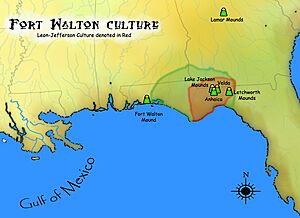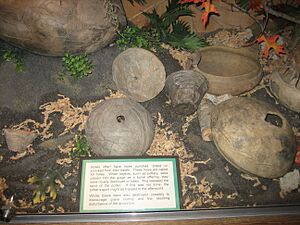Fort Walton culture facts for kids
The Fort Walton culture was a group of Native American people who lived in the southeastern part of North America. They thrived from about 1200 to 1500 CE. Archaeologists believe these people were the ancestors of the Apalachee people we know today.
Contents
What is the Fort Walton Culture?
The name "Fort Walton culture" was first used by an archaeologist named Gordon Willey. He named it after the Fort Walton Mound site in Florida. However, later studies showed that the Fort Walton Mound was actually built by a different group, the Pensacola culture.
Archaeologists now define the Fort Walton culture mainly by the type of pottery they made. These people used sand, grit, or a mix of these materials to strengthen their clay. This process is called "tempering." In contrast, the Pensacola culture used crushed shells for tempering their pottery.
This unique pottery style helps experts identify Fort Walton sites. Their territory stretched from the Aucilla River in the east to the Choctawhatchee Bay in the west. It also went north into parts of Alabama and Georgia. This area included about 107 miles (172 km) up the Apalachicola River and 50 miles (80 km) up the Chattahoochee River.
How the Fort Walton Culture Developed
Around 1000 to 1200 CE, the local Weeden Island culture people started to change their way of life. They began to grow a lot of maize (corn). They also started building large platform mounds. These mounds were used for important ceremonies, political meetings, and religious events.
They also began making new kinds of pottery. These changes were likely influenced by contact with larger Mississippian culture groups. These powerful groups lived to the north and west. Early archaeologists once thought new people came from Mexico or other Mississippian areas. They believed these new groups replaced the Weeden Island people. But by the late 1970s, this idea was mostly disproven. Instead, the local people simply adopted new ideas.
Fort Walton Settlements
Fort Walton settlements were similar to other Mississippian culture sites. However, sites in the Tallahassee Hills area were different. Because of the local land, these sites were built around lakes and swamps instead of rivers.
There were different types of settlements:
- Single family homes
- Small villages with several families
- Small centers with one mound
- Large centers with many mounds
This setup suggests that the area might have had powerful leaders. These leaders, called paramount chiefs, ruled over several communities.
Later Changes and Decline
Later in the Fort Walton period, there was more contact with Lamar Phase people from central Georgia. This led to new styles in how pottery was decorated and made. This new time period is known as the Leon-Jefferson culture.
The Fort Walton way of life began to decline after Europeans arrived. Explorers like Hernando de Soto came through in 1539. Their arrival brought new diseases and conflicts. This caused the native populations to shrink. The Fort Walton and later Leon-Jefferson peoples are the direct ancestors of the Apalachee people.
Timeline of Cultures in the Region
| Period | Dates |
|---|---|
| Weeden Island culture | 400-500 - 1200 CE |
| Fort Walton culture | 1200 - 1500 CE |
| Leon-Jefferson culture | 1500 - 1704 CE |
| Spanish Mission Period | 1633 -1704 CE |
| Creek-Seminole | 1704 - 1850 CE |
Important Fort Walton Sites
The Lake Jackson Mounds site is in Leon County, Florida. It is the largest known ceremonial center of the Fort Walton culture. There are eight other known ceremonial sites in the Apalachee Province. Lake Jackson Mounds was used throughout the entire Fort Walton period. However, it was abandoned around 1500 CE. The main center of the chiefdom then moved to nearby Anhaica. This was the capital when the de Soto expedition camped there in the winter of 1539.
Another large site nearby is the Velda Mound. This site was used from about 1450 to 1625. Other important sites include the Yon Mound and Village Site in Liberty County. The Thick Greenbriar Site in Jackson County is also a notable location.



